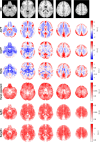Resting-State Functional MRI Analyses for Brain Activity Characterization: A Narrative Review of Features and Methods
- PMID: 41127941
- PMCID: PMC12547649
- DOI: 10.1111/ejn.70276
Resting-State Functional MRI Analyses for Brain Activity Characterization: A Narrative Review of Features and Methods
Abstract
Resting-state fMRI (rsfMRI) is a widely used neuroimaging technique that measures spontaneous fluctuations in brain activity in the absence of specific external cognitive, motor, emotional, and sensory tasks or stimuli, based on the blood-oxygen-level-dependent (BOLD) signal. Functional connectivity (FC) is a popular rsfMRI analysis examining BOLD signal correlations between brain regions. Nevertheless, there are alternative analyses that provide different but collectively informative characteristics of the BOLD signal and, thus, brain activity. This narrative review aimed to provide a comprehensive conceptual, mathematical, and significance investigation of common rsfMRI analyses in addition to FC. To achieve this, a narrative review was conducted on studies using the most common rsfMRI analysis to investigate global and local brain activity. Five rsfMRI analyses were described, summarizing the common initial steps of rsfMRI data processing and explaining the main characteristics and how each metric is calculated. The rsfMRI analyses described are (1) FC, reflecting BOLD global connectivity; (2) the amplitude of low-frequency fluctuations (ALFF) and fractional ALFF (fALFF), representing the intensity of the BOLD signal; (3) regional homogeneity (ReHo), which reflects BOLD local connectivity; (4) Hurst exponent (H), depicting autocorrelation of the BOLD signal; and (5) entropy, depicting the BOLD signal predictability. As rsfMRI is a vital tool for exploring brain function, selecting an analysis that aligns with the research question is essential. This review offers an initial catalog of standard rsfMRI analyses, highlighting their key features, concepts, and considerations to support informed decisions by researchers and clinicians.
Keywords: blood‐oxygen‐level‐dependent (BOLD) signal; functional magnetic resonance imaging (fMRI); global brain activity; local brain activity; low‐frequency fluctuations; neuroimaging; resting state.
© 2025 The Author(s). European Journal of Neuroscience published by Federation of European Neuroscience Societies and John Wiley & Sons Ltd.
Conflict of interest statement
Dr. Noseworthy is the co‐founder and CEO of TBIFinder Inc., a data analytics company that focuses on brain injury. Also, Dr. Danielli and Mr. Amador‐Tejada are part‐time research interns with TBIFinder Inc. There is no overlap between TBIFinder and the current research presented in this review.
Figures




References
-
- Amador‐Tejada, A. , Sharma B., and Noseworthy M. D.. 2024. Resting‐State fMRI (rsfMRI) Analysis Techniques: A Comprehensive Glossary. Retrieved from osf.io/pkz3j.
Publication types
MeSH terms
Grants and funding
LinkOut - more resources
Full Text Sources
Medical
Research Materials

